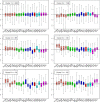Biomarker signatures of aging
- PMID: 28058805
- PMCID: PMC5334528
- DOI: 10.1111/acel.12557
Biomarker signatures of aging
Abstract
Because people age differently, age is not a sufficient marker of susceptibility to disabilities, morbidities, and mortality. We measured nineteen blood biomarkers that include constituents of standard hematological measures, lipid biomarkers, and markers of inflammation and frailty in 4704 participants of the Long Life Family Study (LLFS), age range 30-110 years, and used an agglomerative algorithm to group LLFS participants into clusters thus yielding 26 different biomarker signatures. To test whether these signatures were associated with differences in biological aging, we correlated them with longitudinal changes in physiological functions and incident risk of cancer, cardiovascular disease, type 2 diabetes, and mortality using longitudinal data collected in the LLFS. Signature 2 was associated with significantly lower mortality, morbidity, and better physical function relative to the most common biomarker signature in LLFS, while nine other signatures were associated with less successful aging, characterized by higher risks for frailty, morbidity, and mortality. The predictive values of seven signatures were replicated in an independent data set from the Framingham Heart Study with comparable significant effects, and an additional three signatures showed consistent effects. This analysis shows that various biomarker signatures exist, and their significant associations with physical function, morbidity, and mortality suggest that these patterns represent differences in biological aging. The signatures show that dysregulation of a single biomarker can change with patterns of other biomarkers, and age-related changes of individual biomarkers alone do not necessarily indicate disease or functional decline.
Keywords: biological aging; biomarkers; healthy aging; morbidity and mortality.
© 2017 The Authors. Aging Cell published by the Anatomical Society and John Wiley & Sons Ltd.
Figures



References
-
- Bürkle A, Moreno‐Villanueva M, Bernhard J, Blasco M, Zondag G, Hoeijmakers JHJ, Toussaint O, Grubeck‐Loebenstein B, Mocchegiani E, Collino S, Gonos ES, Sikora E, Gradinaru D, Dollé M, Salmon M, Kristensen P, Griffiths HR, Libert C, Grune T, Breusing N, Simm A, Franceschi C, Capri M, Talbot D, Caiafa P, Friguet B, Slagboom PE, Hervonen A, Hurme M, Aspinall R (2015) MARK‐AGE biomarkers of ageing. Mech. Ageing Dev. 151, 2–12. - PubMed
Publication types
MeSH terms
Substances
Grants and funding
LinkOut - more resources
Full Text Sources
Other Literature Sources
Medical

